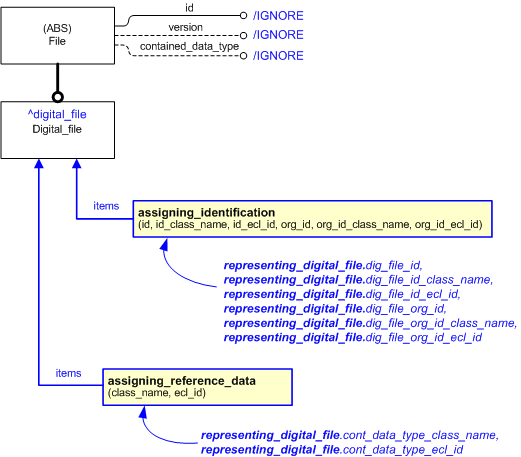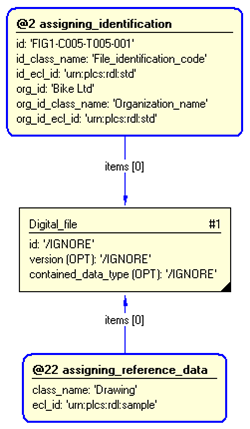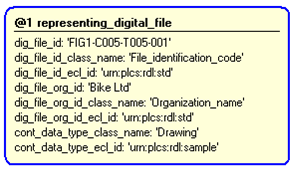Template:— representing_digital_file (rep_dig_file)
Capability:representing_documents |
Date: 2011/07/04 14:31:59
Revision: 1.9
|
This section specifies the template representing_digital_file.
NOTE
The template has been defined in the context of the capability
representing_documents
which provides an overall description of the
relevant parts of the ISO 10303-239 information model and a description
of related templates.
NOTE
An explanation of a template and the associated instantiation path is
provided in the
Template overview
section.
This template describes how to represent a digital file. It does not describe the digital document definition to which a digital
file may belong.
The EXPRESS-G diagram in
Figure
1
shows the templates and EXPRESS entities that are required
to represent the template
"representing_digital_file".
The text highlighted in blue shows the template parameters.
Figure 1 — An EXPRESS-G representation of the Information model for representing_digital_file
The graphic for the template to be used in other EXPRESS-G diagrams
is shown in Figure
2
below.
Figure 2 — The graphical representation of the representing_digital_file template
The following input parameters are defined for this template:
The identifier of the digital file.
The name of the
External_class
being used to classify the identifier assigned to the digital file (i.e. the @dig_file_id)
The following classes and their sub-classes can be used:
The name or identifier of the organization that owns the digital file id (@dig_file_id).
The name of the class being used to classify the identification
of the organization (@dig_file_org_id) responsible for creating the digital file.
The following classes and their sub-classes can be used:
The name of the
External_class
being used to determine the Digital_file type.
The following classes and their sub-classes can be used:
The following reference parameters are defined for this template:
Allow the
Digital_file
entity instantiated in this path to be referenced when this template is used.
Note: The
Digital_file
entity can be referenced in a template path by:
%^target = $representing_digital_file.digital_file%
where
target
is the parameter to which the
Digital_file
is bound.
The following parameter combinations specify a uniqueness constraint:
Unique constraint: Unique digital file
This rule means that there can be only one digital file
(
Digital_file )
with any given combination of identifier and file type.
The instantiation path shown below specifies the entities that are to be
instantiated by the template.
A description of templates and the syntax for the instantiation path is
provided in the
Templates Help/Information section.
Digital_file-- Mark the Digital_file entity as -- referable when this template is used by binding it to the reference -- parameter digital_file %^digital_file =
Digital_file%
Digital_file.id = '/IGNORE'
Digital_file.version = '/IGNORE'
Digital_file.contained_data_type = '/IGNORE'
-- Identify the Digital_file /
assigning_identification(
items=^digital_file,
id=@dig_file_id,
id_class_name=@dig_file_id_class_name,
id_ecl_id=@dig_file_id_ecl_id,
org_id=@dig_file_org_id,
org_id_class_name=@dig_file_org_id_class_name,
org_id_ecl_id=@dig_file_org_id_ecl_id )/
-- provide the contained data type of the digital_file by classification /
assigning_reference_data(
items=^digital_file,
class_name=@cont_data_type_class_name,
ecl_id=@cont_data_type_ecl_id)/
The following entities are instantiated with attributes as specified:
The instance diagram in Figure
3
shows an example of the EXPRESS entities and templates that are instantiated by the template:
/representing_digital_file(dig_file_id='FIG1-C005-T005-001', dig_file_id_class_name='File_identification_code', dig_file_id_ecl_id='urn:plcs:rdl:std', dig_file_org_id='Bike Ltd', dig_file_org_id_class_name='Organization_name', dig_file_org_id_ecl_id='urn:plcs:rdl:std', cont_data_type_class_name='Drawing', cont_data_type_class_name_ecl_id='urn:plcs:rdl:sample')/
(an illustration of the consolidated representing_digital_file template is shown in
Figure
4 below.)
Figure 3 — Entities instantiated by representing_digital_file template
The instance model in STEP ASCII exchange file format (ISO 10303 Part
21 syntax) is:
DATA;
#1 = DIGITAL_FILE('/IGNORE','/IGNORE','/IGNORE');
#3 = IDENTIFICATION_ASSIGNMENT('FIG1-C005-T005-001','/IGNORE','/IGNORE',(#1));
#5 = CLASSIFICATION_ASSIGNMENT(#6,(#3),'/IGNORE');
#6 = EXTERNAL_CLASS('/NULL','File_identification_code','/IGNORE',#7);
#7 = EXTERNAL_CLASS_LIBRARY('urn:plcs:rdl:std','/IGNORE');
#10 = ORGANIZATION('/IGNORE','/IGNORE');
#12 = IDENTIFICATION_ASSIGNMENT('Bike Ltd','/IGNORE','/IGNORE',(#10));
#14 = CLASSIFICATION_ASSIGNMENT(#15,(#12),'/IGNORE');
#15 = EXTERNAL_CLASS('/NULL','Organization_name','/IGNORE',#7);
#17 = ORGANIZATION_OR_PERSON_IN_ORGANIZATION_ASSIGNMENT(#10,'/IGNORE',(#3));
#19 = CLASSIFICATION_ASSIGNMENT(#20,(#17),'/IGNORE');
#20 = EXTERNAL_CLASS('/NULL','Owner_of','/IGNORE',#7);
#23 = CLASSIFICATION_ASSIGNMENT(#24,(#1),'/IGNORE');
#24 = EXTERNAL_CLASS('/NULL','Drawing','/IGNORE',#25);
#25 = EXTERNAL_CLASS_LIBRARY('urn:plcs:rdl:sample','/IGNORE');
ENDSEC;
The instance diagram in
Figure
4
shows the graphic symbol for the template that is to be
used in other instance diagrams. The example template is:
/representing_digital_file(dig_file_id='FIG1-C005-T005-001', dig_file_id_class_name='File_identification_code', dig_file_id_ecl_id='urn:plcs:rdl:std', dig_file_org_id='Bike Ltd', dig_file_org_id_class_name='Organization_name', dig_file_org_id_ecl_id='urn:plcs:rdl:std', cont_data_type_class_name='Drawing', cont_data_type_class_name_ecl_id='urn:plcs:rdl:sample')/
Figure 4 — Entities instantiated by representing_digital_file template
Characterizations
No common characterizations of the template
representing_digital_file
have been identified. However, the ISO 10303-239 EXPRESS model
may enable other assignments to the entities instantiated by the template.




